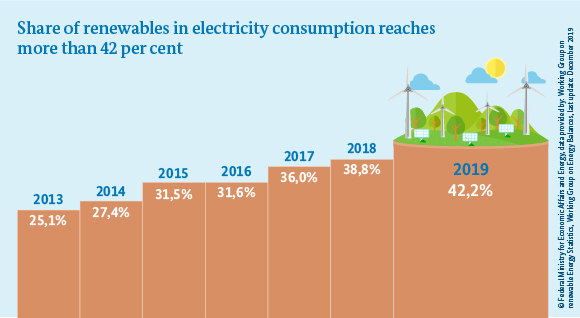Renewable energy levels reach record high
According to figures provided by the Working Group on Energy Balances, more than 42 per cent of Germany’s electricity came from renewables in 2019.
 © Federal Ministry for Economic Affairs and Energy, data provided by: Working Group on renewable Energy Statistics, Working Group on Energy Balances, last update: December 2019
© Federal Ministry for Economic Affairs and Energy, data provided by: Working Group on renewable Energy Statistics, Working Group on Energy Balances, last update: December 2019
In 2019, the share of electricity that came from renewables was higher than ever before, accounting for around 42 per cent of Germany’s gross electricity consumption. Just to put this figure into perspective: Back in 2013, renewables contributed around 25 per cent. Since then, their share has continued to grow.
At the same time, conventional sources of energy continue to lose in importance. This is particularly evident in the share of conventional energy commodities in electricity generation. The share of electricity from hard coal in the electricity mix fell to 9.3 per cent. This was particularly due to rising prices for CO2 allowances and lower prices for purchasing gas.
The share of electricity from lignite in the electricity mix also shrank, falling from 22.6 per cent in 2018 to now 18.6 per cent. This development was spurred on by higher allowance prices and the expansion of renewable energy. The last time Germany generated as little lignite-fired electricity as last year was back in 1970. And conventional power as a whole fell to its lowest level since 1990, the year records for reunified Germany began. Wind and solar power are seeing the opposite trend. At 173.1 terawatt-hours, electricity from these sources combined for the first time overtook coal (at 170.9 terrawatt-hours).
Nuclear power saw a slight decline (minus 0.8 terrawatt-hours). Its share in electricity consumption was 12.3 per cent in 2019. With the Philippsburg 2 nuclear power station having been taken off the grid at the end of 2019, the share of coal-fired power is expected to be even lower in 2020. The figures provided here are based on estimates provided by the Working Group on Energy Balances.

